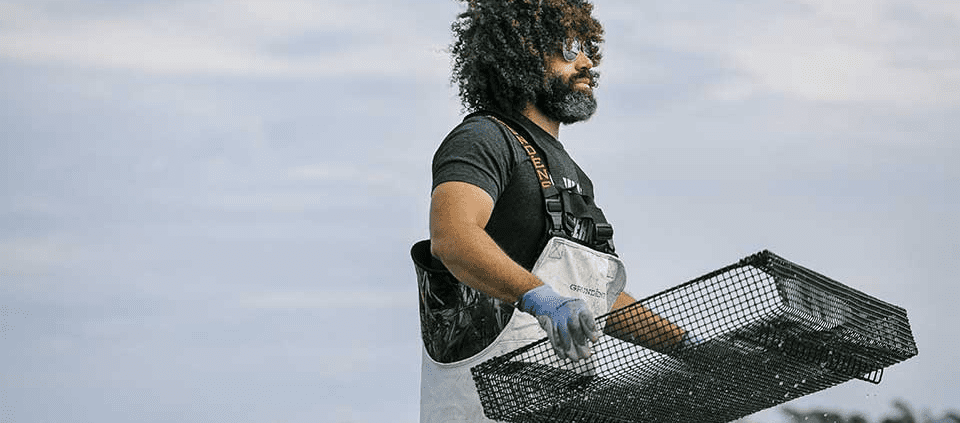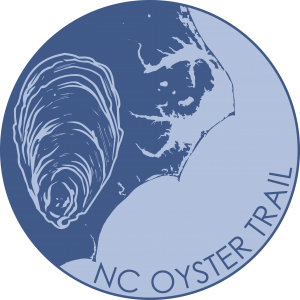North Carolina Oyster Farmer Ryan Bethea On Making Oysters Accessible Across the State
Talking with Ryan Bethea about the science behind his ultra-briny bivalves and his path to farming.
by Lena Geller on December 15th, 2024 | Reprinted from Indy Week

Oyster farmer Ryan Bethea. Photo by Jeyhoun Allebaugh. Credit: Courtesy of Oysters Carolina
On a typical winter morning, Ryan Bethea might wake up on the North Carolina coast in 65-degree weather, harvest oysters in his shirtsleeves, and end the day trudging through snow on the other side of the state.
Dramatic temperature swings and marathon deliveries are all part of the job, says Bethea, whose operation is unique in the industry: he texts customers photo proof of their oysters being harvested, then delivers them the same day.
A Durham native, Bethea launched Oysters Carolina—a sustainable shellfish farm on Harkers Island—in 2015, with an unconventional approach: no minimum orders, free delivery anywhere in North Carolina. Though he’s had to adjust some policies since then (there’s now a 50-oyster minimum for most orders), his commitment to accessibility has earned him a uniquely diverse customer base that spans every corner of the state.
On Sunday, Bethea brought his signature Beau Sel oysters (“beautiful salt,” in French) to Krill in Durham for an afternoon oyster roast.
While he was in town, the INDY caught up with Bethea to discuss the science behind his ultra-briny bivalves, his path to oyster farming, and why same-day delivery is worth endless hours on the road.
INDY: Tell me about your path to oyster farming.
Bethea: After high school, I went to play college soccer for a couple years, partied too much, and then started bartending and traveling around the country, bartending here and there. I was working at this place in South Durham by New Hope Commons, I can’t remember what it’s called, and I had dress shoes on and was walking on these beautiful floors. And just the sound of nice dress shoes on wooden floors—I don’t know what it was, but it triggered something in me. Like, “It’s time for me to do something meaningful with my life.” You only hear that sound if you’re walking in a courthouse or a nice building.
I went back to school and got a degree in geography at North Carolina Central. The geography program is magnifique.
In North Carolina, if you have a certain degree and a certain GPA, you can start teaching while earning your certificate. It’s called lateral entry. I got a call from Principal Lovett at Terrell Lane, a Title One school in Franklin County. I turned 30 on a Saturday, worked a bar shift that night, and started teaching the following Wednesday. It was freaking crazy.
What made you want to get into the oyster industry?
I read an article that talked about how North Carolina has pristine water but didn’t have an oyster industry like Virginia or South Carolina. It was this exciting industry in its infancy, and I wanted to be part of building it.
Do you see any parallels between teaching and oyster farming?
I mean, it’s all kind of stewardship—you’re growing oysters, you’re growing people. I don’t know how successful I was as a teacher, but I definitely cared about the kids, and I hope they felt that. With the oysters, we hope people can taste how much we care. It’s kind of like when you bake an apple pie with love in it, you know what I’m saying? It’s kind of corny, but…
I know what you’re saying. Tell me about your oysters. I saw they’re known for being particularly salty?
Everything on the East Coast, from Newfoundland all the way to the Gulf, is all one species—it’s called Crassostrea virginica, just the Eastern oyster. But similar to wine, if you take a grape and grow it in France, it’s going to taste different than if you put it in Spain or Argentina. In aquaculture, they call it merroir, like terroir but of the sea. Even two oyster farms 600 yards apart are going to taste different depending on the mouth of the river, what food is available, how much salt water inundation there is.
Our farm is 31 to 33 parts per thousand salt. The ocean is 33 to 35, so it’s pretty much a marine environment. Here’s something wild—there are no oysters in the ocean.
Really?
Yeah, it’s crazy, right? The ocean is too salty for them. They need brackish water to grow best, about 20 to 22 parts per thousand salt. So it stresses the animals, putting them in such a high salinity area. That’s why not a lot of people grow them in high-salinity areas. We’re really fortunate that we’ve got a process that works.
What does a typical week look like for you?
The one restaurant we sell to is Herons at The Umstead Hotel in Cary. So a few days a week, I’m getting up, driving out to the farm, harvesting oysters, taking pictures and videos with a timestamp, texting that to Chef, and heading straight there. Let’s call that Monday and Wednesday. Then Fridays are our delivery day for everybody else.
Tell me about your customer base—who’s ordering these oysters?
It’s literally everyone. We’ve got farmers in Weldon, professors living out in the woods in Pittsboro, college students in Greensboro, bankers in Charlotte. When we first started, we didn’t have a minimum order and delivery was free. We wanted to get oysters to people in rural areas, elderly folks who can’t travel. Now we’ve had to add the 50-oyster minimum, but if you qualify for EBT or any government assistance, we’ll bring you free oysters.




